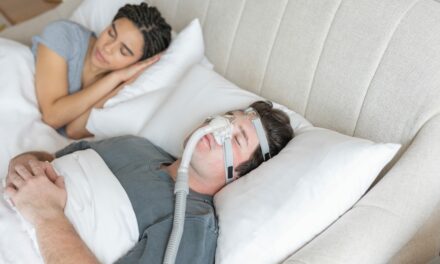
A major problem with using continuous positive airway pressure (CPAP) to treat obstructive sleep apnea (OSA) is that many patients are nonadherent. Patients who are nonadherent often continue in a downward spiral of constant sleep disturbance and the associated deterioration of their health and well-being. Despite the medical community’s best efforts to encourage adherence, close to half of the patients who start on CPAP therapy for OSA are no longer using the device within the first year.1 Adherence has been defined by the World Health Organization as “the extent to which a person’s behavior—taking medication, following diet, and/or executing lifestyle changes—corresponds with agreed recommendations from a health care provider.”2 Adherence involves the patient’s willingness to follow the plan of care that has been recommended. Improving adherence to therapy in OSA patients may be shaped and influenced by what is being done for patients with another chronic disease—diabetes.
Diabetes is a disease that has many similarities to OSA. It has become more prevalent and is a chronic disease that contributes to many health problems. Treatment for diabetes involves lifestyle changes, is intrusive and inconvenient, and prevention rather than cure may be the main goal of therapy.3 The health problems related to diabetes are serious; it is included in the leading causes of blindness, renal failure, and amputation of the lower limbs, and is one of the major causes of death related to cardiovascular complications.4 Reasons for nonadherence in diabetes (and other chronic diseases) are common and include “simple forgetfulness, changes in daily routine, depression or substance abuse, uncertainty about the effectiveness of treatment, lack of knowledge about the consequences of poor adherence, regimen complexity, poor social support, economic problems, and treatment side effects.”3 In both OSA and diabetes, patients are often dealing with a lifelong condition that calls for ongoing, daily treatment. Nonadherence to the therapy to treat the condition has dire consequences long-term, while adherence can have an immediate change in the quality of life, improved overall health, and reduction in comorbid issues.
Comparison of these two conditions needs to include some distinct differences. OSA is treated with nightly application of CPAP, the patient needs to monitor/adjust the equipment, and OSA does not create an acute crisis situation if treatment is delayed for a day or two. Diet and exercise that result in weight loss can affect the need for CPAP, but unfortunately are often not an integral part of the treatment plan. On the other hand, diabetes involves daily monitoring of blood glucose, careful attention to diet and exercise to control glucose levels, and often requires taking medication to reduce the blood glucose when it gets too high. If a very high glucose level goes untreated, the result can be a diabetic ketoacidosis, diabetic coma, or death over the course of hours to days.5
HEALTH BELIEFS
For both diseases, many factors should be considered when trying to address the problem of nonadherence. Demographic issues such as belonging to an ethnic minority, low socioeconomic status, and level of education have been shown to impact self-monitoring of blood glucose3,6 and some of these same factors have been influential in adherence to using CPAP.1 Psychological factors influence adherence to treatment strategies for both diseases. The patient needs to perceive that the treatment makes sense, is effective, and has benefits that exceed the costs. The patient needs to feel they can successfully impact the disease by using the therapy—that their participation makes a difference. These psychological factors have been described as “health beliefs” and are linked to the notion that these beliefs tend to drive the patient’s health behaviors.7
In a study published in Sleep Medicine in 2009, Poulet et al examined if they could use psychological variables (including these “health beliefs”) to predict adherence to CPAP therapy and found that they could correctly identify 85.7% of the nonadherent patients.7 Nonadherence was gauged by the average number of hours of CPAP run time each night for the first month of CPAP therapy and was defined as using the CPAP <4 hours/night averaged throughout the month. The nonadherent patients could be identified based on four factors: their age, scores from the Nottingham Health Profile (a health perceptions questionnaire), the Apnea Belief Scale, and the Apnea Knowledge Test.7 By predicting those who are likely to be nonadherent, an individualized educational approach and a more focused disease management plan can be put into place, which should increase adherence. Stress, depression, and anxiety have been shown to increase nonadherence in both diabetic and OSA patients. Social support from family members and spouses can have a positive effect on adherence to therapy in both disease conditions.1,3,6
THE SUPPORT TEAM
The health care system and the health care provider along with the support team of health care professionals promote adherence to therapy in both diseases. Quick follow-up for phone calls and effective trouble-shooting for problems have been shown to increase adherence in CPAP users.1 Frequent contact by telephone offers encouragement, continuing education, and advice, and brings problem-solving actions to the patient in a quick, convenient manner. Changing the caregiving system to be sure these interventions are included promotes adherence. Patients who are active in their treatment and get involved with self-monitoring and self-management will “buy-in” to the treatment and be motivated to continue with the plan of care. Diabetes research has shown that behavioral change in the patient is influenced by a collaborative relationship with their provider. The following quote is from Lerman’s article on adherence to diabetes treatment:
Practice system changes that have shown the greatest promise of success integrate self-management support programs. They include guideline-based treatment plans, nurse case management programs, group sessions with leaders trained in motivation strategies, complete programs based on goal achievements, 2- to 3-day intensive courses as part of reinforcement programs and, particularly, an adequate patient-physician relationship with intensive follow-up, reminders and feedback.3
Consider how this quote compares to remarks from Bollig’s article on adherence to CPAP therapy:
Adherence is dependent on layers of information providing the patient with ongoing education, written instructions, demonstration of equipment, and the timely addressing and troubleshooting of the patient’s concerns and problems. Staff knowledgeable in managing sleep disorders should be readily accessible and be able to provide feedback and troubleshoot equipment issues in addition to providing a mask-fitting service…. CPAP adherence is dependent on building the layers of patient-clinician relationship through sleep center follow-up, telephone follow-ups, and home visits by home-medical-equipment, RT, or home nursing service. Support and continued education through the primary care physician office, support groups, and potential internet resources is also key. The timing of follow-up visits is crucial, as prompt attention to early adverse effects, concerns, or patient fears will help to set the pattern of therapy adherence that is normally established in the early days of therapy. The timing of follow-ups should probably be in the first few days after treatment is initiated, and then routinely at around 6 weeks, 3 months, 6 months, and yearly.1
The most successful treatment/management strategies for both diseases involve common factors. A special team of health care professionals needs to be involved in caring for diabetic patients, including a trained and qualified primary care provider, nurse, dietician, exercise therapist, and psychologist—all of whom are knowledgeable about the disease. These same team members can be utilized in caring for the OSA patient, with the addition of a sleep professional/respiratory therapist (for the issues related to CPAP and possibly oxygen therapy if appropriate). Support from family and friends and having equipment that is easy to use, comfortable, and reliable contribute to adherence. However, the key to successful management of both diseases is the patient who is involved in their own awareness of the disease, is actively monitoring their symptoms, and is using the appropriate treatment for the disease. A patient may have the highest quality health care team offering the best of care, but if the patient does not participate—all is for naught and adherence will be minimal to none.
Bill Pruitt, MBA, RRT, CPFT, AE-C, is a senior instructor and director of clinical education in the Department of Cardiorespiratory Sciences, College of Allied Health Sciences, at the University of South Alabama in Mobile, and a PRN therapist at Springhill Medical Center and Mobile Infirmary Medical Center in Mobile. He can be reached at [email protected].
REFERENCES
- Bollig SM. Encouraging CPAP adherence: it is everyone’s job. Resp Care. 2010;55(9):1230-1239.
- Report on Medication Adherence. Geneva: World Health Organization; 2003.
- Lerman I. Adherence to treatment: the key for avoiding long-term complications of diabetes. Arch Med Res. 2005;36(3):300-306.
- Wens J, Vermeire E, Hearnshaw H, Lindenmeyer A, Biot Y, Van Royen P. Educational interventions aiming at improving adherence to treatment recommendations in type 2 diabetes: a sub-analysis of a systematic review of randomized controlled trials. Diabetes Res Clin Pract. 2008;79(3):377-388.
- PubMed Health A.D.A.M. Medical Encyclopedia article on diabetes. www.ncbi.nlm.nih.gov/pubmedhealth/PMH0002194/. Accessed August 30, 2011.
- Delamater A. Improving patient adherence. Clin Diabetes. 2006;24:271-77.
- Poulet C, Veale D, Arnol N, Levy P, Pepin JL, Tyrrell J. Psychological variables as predictors of adherence to treatment by continuous positive airway pressure. Sleep Med. 2009;10(9):993-999.





